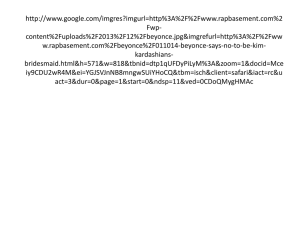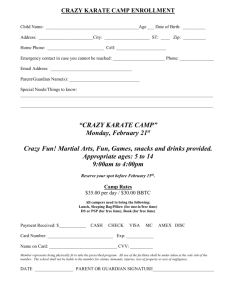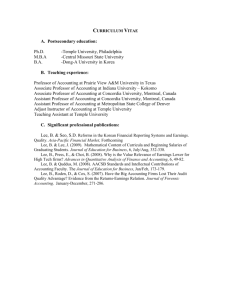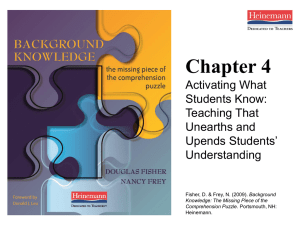Crazy or Not!!
advertisement
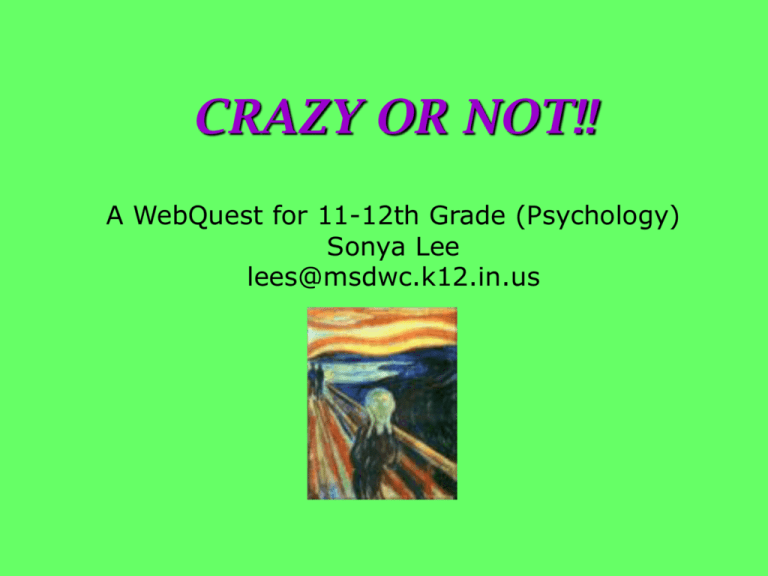
CRAZY OR NOT!! A WebQuest for 11-12th Grade (Psychology) Sonya Lee lees@msdwc.k12.in.us Introduction Introduction | Task | Process | Evaluation | Conclusion | Standards | Resources | Teacher Notes Crazy, crazy, crazy!! Have you ever been called this or have you ever called anyone this? In this WebQuest you will be investigating different types of psychological disorders. You will find out if a disorder is permanent or not. What are the treatment options and much more. Crazy or Not!! Sonya Lee October 15, 2004 The Task Introduction | Task | Process | Evaluation | Conclusion | Standards | Resources | Teacher Notes This project will be completed with a partner. Each group will need to pick a psychological disorder that you will investigate. Together you will create and present a PowerPoint presentation. Each person will need to write a reflection paper describing what you have learned during this process. Crazy or Not!! Sonya Lee October 15, 2004 The Process Introduction | Task | Process | Evaluation | Conclusion | Standards | Resources | Teacher Notes 1. 2. 3. 4. First will need to get with a partner and tell your teacher with whom you are working. Second you will need to pick a psychological disorder from the list. Create a 10-15 slide PowerPoint covering the following: definition of illness, causes, rate of occurrence, symptoms, and treatment methods. Type a reflection paper: - 1-2 pages - typed double spaced - technical font - font size of 12 - one inch margins - IBC. Crazy or Not!! Sonya Lee October 15, 2004 Evaluation Introduction | Task | Process | Evaluation | Conclusion | Standards | Resources | Teacher Notes Each of you will receive a group grade based upon the PowerPoint and oral presentation. You also will receive an individual grade for the reflection paper. Evaluation continued on Next Page Crazy or Not!! Sonya Lee October 15, 2004 PowerPoint Evaluation Introduction | Task | Process | Evaluation | Conclusion | Standards | Resources | Teacher Notes CATEGORY At t ract iveness 4 Makes excellent use of font , color, graphics, effect s, et c. t o enhance t he present at ion. 3 Makes good use of font , color, graphics, effect s, et c. t o enhance t o present at ion. 2 Makes use of font , color, graphics, effect s, et c. but occasionally t hese det ract from t he present at ion cont ent . 1 Use of font , color, graphics, effect s et c. but t hese oft en dist ract from t he presenat ion cont ent . Mechanics No misspellings or grammat ical errors. Three or fewer misspellings and/or mechanical errors. Four misspellings More t han 4 and/or grammat ical errors in spelling errors. or grammar. Rubric Continued on Next Slide Play Dolls or Play Ball! Sonya Lee August 2004 PowerPoint Evaluation Introduction | Task | Process | Evaluation | Conclusion | Standards | Resources | Teacher Notes CATEGORY Cont ent Organizat ion 4 Covers t opic indept h wit h det ails and examples. Subject knowledge is excellent . 3 Includes essent ial knowledge about t he t opic. Subject knowledge appears t o be good. Cont ent is well Uses headings organized using or bullet ed list s headings or bullet ed t o organize, but list s t o group t he overall relat ed mat erial. organizat ion of t opics appears flawed. Rubric Continued on Next Slide 2 Includes essent ial informat ion about t he t opic but t here are 12 fact ual errors. 1 Cont ent is minimal OR t here are several fact ual errors. Cont ent is logically organized for t he most part . There was no clear or logical organizat ional st ruct ure, just lot s of fact s. Play Dolls or Play Ball! Sonya Lee August 2004 PowerPoint Evaluation Introduction | Task | Process | Evaluation | Conclusion | Standards | Resources | Teacher Notes CATEGORY Oral Present at ion 4 Int erest ing, wellrehearsed wit h smoot h delivery t hat holds audience at t ent ion. 3 Relat ively int erest ing, rehearsed wit h a fairly smoot h delivery t hat usually holds audience at t ent ion. 2 Delivery not smoot h, but able t o hold audience at t ent ion most of t he t ime. 1 Delivery not smoot h and audience at t ent ion lost . Workload The workload is divided and shared equally by all t eam members. The workload is divided and shared fairly by all t eam members, t hough workloads may vary from person t o person. The workload was divided, but one person in t he group is viewed as not doing his/her fair share of t he work. The workload was not divided OR several people in t he group are viewed as not doing t heir fair share of t he work. Evaluation for Paper on Next Page Play Dolls or Play Ball! Sonya Lee August 2004 Paper Evaluation Introduction | Task | Process | Evaluation | Conclusion | Standards | Resources | Teacher Notes Category 4 3 2 1 Requirements All requirements : typed, font, length, and IBC were met. One requirement was not met. Two requirements were not met. Three or more requirements were not met. Paragraph Construction All paragraphs include introductory sentence, explanations or details, and concluding sentence. One element of the paragraphs was omitted. Two elements of the paragraph s were omitted. Three or more elements of the paragraphs were omitted. Mechanics No grammatical, spelling or punctuation errors. 1-2 grammatical, spelling or punctuation errors. 3-4 grammatical, spelling or punctuation errors. More than 4 grammatical, spelling or punctuation errors. Play Dolls or Play Ball! Sonya Lee August 2004 Conclusion Introduction | Task | Process | Evaluation | Conclusion | Standards | Resources | Teacher Notes Crazy or Not !! • By the end of this WebQuest you will have researched one specific psychological disorders including causes, symptoms, and treatments. • This WebQuest should also have shown you where you can find information and help if you know someone with a psychological disorder. • How will you use this information to help others? Crazy or Not!! Sonya Lee October 15, 2004 Standards Introduction | Task | Process | Evaluation | Conclusion | Standards | Resources | Teacher Notes Standard 4 – Personality, Assessment, and Mental Health Students will recognize that personality is the distinctive and relatively stable pattern of behaviors, thoughts, motives, and emotions that characterize an individual. They will also identify the different types and functions of assessment instruments; understanding the factors that contribute to mental health, stress, and mental illness, and identify approaches for treatment of mental health problems. P.4.1 Identify the factors that may influence the formation of personality. P.4.11 Describe availability and appropriateness of various modes of treatment for people with psychological disorders. P.4.12 Describe characteristics of effective treatment and prevention. Crazy or Not!! Sonya Lee October 15, 2004 Resources Introduction | Task | Process | Evaluation | Conclusion | Standards | Resources | Teacher Notes • Mental Health Matters: List of Psychological Disorders – list the different disorders and has links for each disorder • Links to Psychological Disorders Sites • NATIONAL INSTITUTE OF MENTAL HEALTH Web Site • Contact the local Mental Health Association Crazy or Not!! Sonya Lee October 15, 2004 Teacher Notes Introduction | Task | Process | Evaluation | Conclusion | Standards | Resources | Teacher Notes • The students will be given one week of class time to work on this project. Our school is on a traditional 6 classes per day. • You will need to decide what disorders you will allow them to research within the area of psychological disorders. • For the reflection paper IBC will be discussed in class which stands for introduction, body, and conclusion. • It is expected that students have prior knowledge on creating PowerPoint presentations. If needed handouts can be obtained from the technical assistant. Email Mrs. Lee Crazy or Not!! Sonya Lee October 15, 2004
